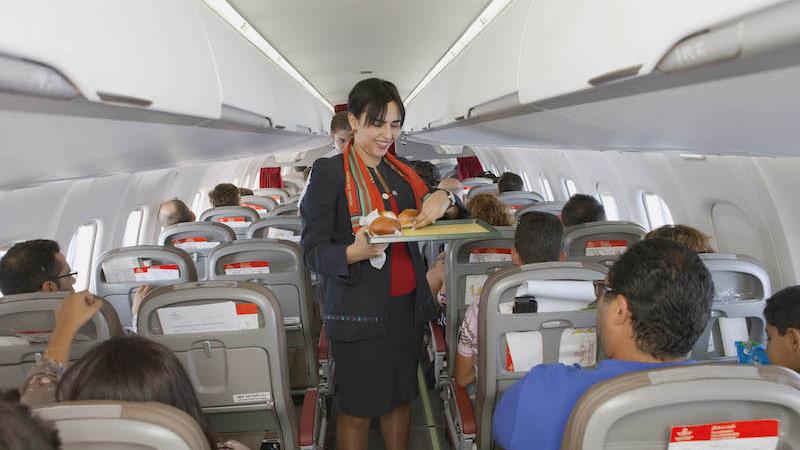Alan Dron speaks to Peter Landquist from CTT Systems about the benefits of managing humidity levels on an aircraft.
It benefits an airline to keep certain areas of its aircraft as dry as possible yet increase humidity levels in others.
In an aircraft, the space between the cabin wall and the outer fuselage skin contains insulation blankets. In service, the moisture from passengers’ breath is removed from the cabin and condenses into frost on the cold fuselage skin. During the descent, that frost melts and some of it soaks into the insulation blankets.
Eventually, the blankets become saturated. And water is heavy, with every litre adding a kilogram to the aircraft’s weight. This means that the aircraft’s engines must work that little bit harder to fly unwanted water along the airways.
Swedish company CTT Systems’ has deployed its CAIR system to solve this problem of high humidity levels by reducing that moisture. By removing water, and thus weight, from that layer of insulation, CTT can promote its Zonal Drying system to airlines as a cost-saver.
At the same time, the CAIR system is designed to increase moisture where it is needed, in the cabin, to promote passenger comfort levels. But how do you convince those airlines to put a humidification system on board when it does something as intangible as increase moisture levels in the cabin?
“The latter can be a difficult sell”, admits Peter Landquist, CTT Systems’ vice-president for sales and marketing. The easy part first: reducing water levels in the insulation can cut the weight of an Airbus A320 in high-density configuration, for example, by almost 300kg.
That weight reduction has been proven by multiple weighing’s, says Landquist.
He says the reduction can make a small but measurable improvement to the aircraft’s fuel burn and emissions. “With the bottom line being all-important, that is a tangible benefit, especially for LCCs that aim to shave every possible factor in their operating costs.”
Not only are direct fuel costs reduced but reductions in emissions are likely to become more important as new anti-pollution measures are enforced by bodies such as the European Union and the International Civil Aviation Organization.

Now the harder part of the equation: what benefits accrue to an airline from making its cabin air more humid?
“Anyone who has been on a flight of more than three to four hours knows that when they walk off the aircraft, they often feel less spry than when they got on board. Partly that is due to being seated in a confined space, but it is also partly because of the dryness of the onboard atmosphere.”
It has long been known, for example, that conditions on board aircraft dry out the body’s membranes, hence that gritty-eyed feeling that many experience. Additionally, dried-out nasal membranes are more likely to be penetrated by viruses; one recent study claimed that as many as 20 per cent of passengers contract some form of sore throat or similar infection within five days of a flight.
Ironically, the problem is at its worst in the premium cabins, as the lower passenger density there means that the atmosphere there can be drier than in the Sahara or the Arctic.
Until recently, this would not have been a problem for low-cost carriers [LCCs] which have generally shunned premium cabins, or for regional carriers, which have short sectors and any ‘business class’ is likely to be no more than a little extra legroom in the main cabin.
However, the advent of long-haul, low-cost carriers, which are often keen to establish premium cabins to improve overall yield, means that they, too, may have to start considering the problem of the lack of humidity.
Humidification systems have been in use in flight decks and crew rest areas for some time, says Landquist. “They’re very popular with pilots, who are exposed to an extremely dry atmosphere. They say they can really feel the difference – it’s a big improvement.’”
However, unlike the Zonal Drying system, the humidification aspect of the CAIR system provides no obvious cost benefit. “It has to be sold as a passenger service,” Landquist adds.
CTT can point to both scientific research and customer feedback that improved humidity conditions and result in passengers feeling better on reaching their destinations.

The company argues that it enhances other improvements such as new seats and dining options that carriers have made in their premium cabins. For example, improved sense of taste and smell in a moister atmosphere means that airlines do not have to dose their in-flight meals with sugar or salt to boost passengers’ perception of flavours.
These are individually small factors but, when combined, can create a differentiator between airlines. If passengers, especially those in the high-paying premium cabins, start to realise that they get off a flight feeling better and more ready to go straight into a business meeting, for example, they are more likely to use that airline in future.
Meanwhile, one possible financial benefit from an airline’s point of view is that a more humid atmosphere in premium cabins, says CTT, lessens the risk of static discharge, which can damage electrical components.
Intangibles such as noise, temperature, draughts and pressurisation levels are all important in a cabin, especially a premium one and have largely been addressed, Landquist confirms. “The last step now is humidity.”
LCCs are taking more interest in the company’s systems, he states: “Europe is our main market and Russia has become a very good market in the past two to three years.”
So far, CTT has installed its systems in around 1,500 aircraft. Landquist and his colleagues hope that number will rise as more carriers become aware of both the financial and passenger comfort benefits.
Visit ctt.se for more information.



